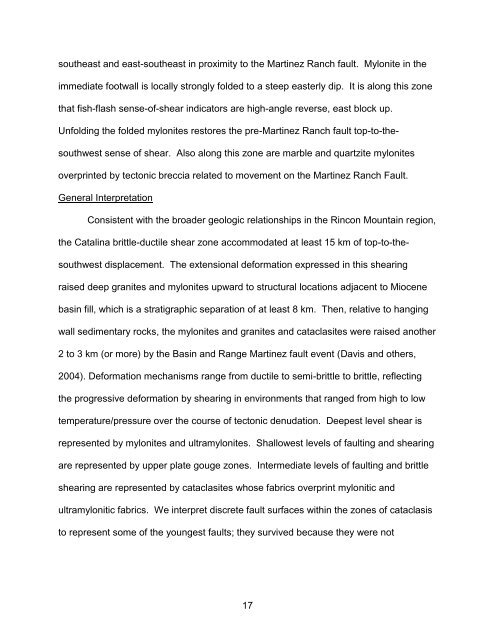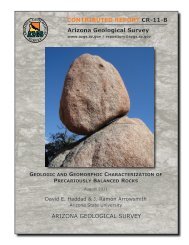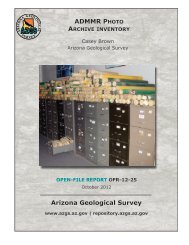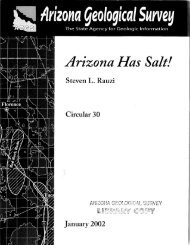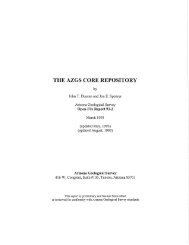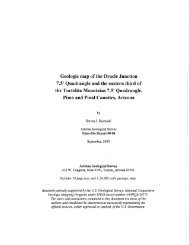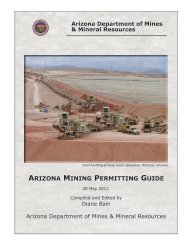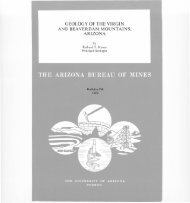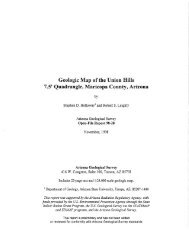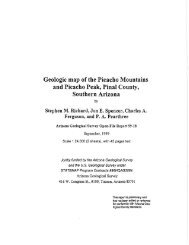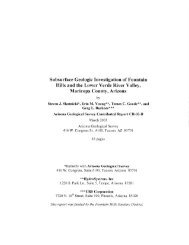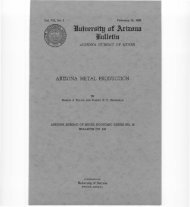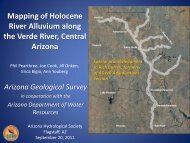sou<strong>the</strong>ast and east-sou<strong>the</strong>ast <strong>in</strong> proximity to <strong>the</strong> Mart<strong>in</strong>ez <strong>Ranch</strong> fault. Mylonite <strong>in</strong> <strong>the</strong> immediate footwall is locally strongly folded to a steep easterly dip. It is along this zone that fish-flash sense-of-shear <strong>in</strong>dicators are high-angle reverse, east block up. Unfold<strong>in</strong>g <strong>the</strong> folded mylonites restores <strong>the</strong> pre-Mart<strong>in</strong>ez <strong>Ranch</strong> fault top-to-<strong>the</strong>- southwest sense of shear. Also along this zone are marble and quartzite mylonites overpr<strong>in</strong>ted by tectonic breccia related to movement on <strong>the</strong> Mart<strong>in</strong>ez <strong>Ranch</strong> Fault. General Interpretation Consistent with <strong>the</strong> broader geologic relationships <strong>in</strong> <strong>the</strong> R<strong>in</strong>con Mounta<strong>in</strong> region, <strong>the</strong> Catal<strong>in</strong>a brittle-ductile shear zone accommodated at least 15 km of top-to-<strong>the</strong>- southwest displacement. The extensional deformation expressed <strong>in</strong> this shear<strong>in</strong>g raised deep granites and mylonites upward to structural locations adjacent to Miocene bas<strong>in</strong> fill, which is a stratigraphic separation of at least 8 km. Then, relative to hang<strong>in</strong>g wall sedimentary rocks, <strong>the</strong> mylonites and granites and cataclasites were raised ano<strong>the</strong>r 2 to 3 km (or more) by <strong>the</strong> Bas<strong>in</strong> and Range Mart<strong>in</strong>ez fault event (Davis and o<strong>the</strong>rs, 2004). Deformation mechanisms range from ductile to semi-brittle to brittle, reflect<strong>in</strong>g <strong>the</strong> progressive deformation by shear<strong>in</strong>g <strong>in</strong> environments that ranged from high to low temperature/pressure over <strong>the</strong> course of tectonic denudation. Deepest level shear is represented by mylonites and ultramylonites. Shallowest levels of fault<strong>in</strong>g and shear<strong>in</strong>g are represented by upper plate gouge zones. Intermediate levels of fault<strong>in</strong>g and brittle shear<strong>in</strong>g are represented by cataclasites whose fabrics overpr<strong>in</strong>t mylonitic and ultramylonitic fabrics. We <strong>in</strong>terpret discrete fault surfaces with<strong>in</strong> <strong>the</strong> zones of cataclasis to represent some of <strong>the</strong> youngest faults; <strong>the</strong>y survived because <strong>the</strong>y were not 17
<strong>the</strong>mselves overpr<strong>in</strong>ted by yet younger fault<strong>in</strong>g and brecciation. The best such example is <strong>the</strong> subdetachment fault. References Crittenden, M.D., Jr., Coney, P.J., and Davis, G.H., 1980, Cordilleran metamorphic core complexes: <strong>Geologic</strong>al Society of America Memoir 153, 18 articles, 490 pp. Damon, P.E., and Shafiqullah, M., 2006, K-Ar dates of fault rocks along <strong>the</strong> Catal<strong>in</strong>a detachment fault, Tanque Verde Ridge, R<strong>in</strong>con Mounta<strong>in</strong>s, Arizona: Arizona <strong>Geologic</strong>al Survey Contributed Report CR-06-A, 18 p. Davis, G.H., 1975, Gravity-<strong>in</strong>duced fold<strong>in</strong>g off a gneiss dome complex, R<strong>in</strong>con Mounta<strong>in</strong>s, Arizona: <strong>Geologic</strong>al Society of America Bullet<strong>in</strong>, v. 86, pp. 979-990. Davis, G. H., 1980, <strong>Structural</strong> characteristics of metamorphic core complexes, sou<strong>the</strong>rn Arizona, <strong>in</strong> M.D. Critenden, Jr., P. J. Coney, and G. H. Davis (eds.), Cordilleran metamorphic core complexes: <strong>Geologic</strong>al Society of America Memoir 153, p. 35- 77. Davis, G.H., 1981, Regional stra<strong>in</strong> of <strong>the</strong> superposed deformations <strong>in</strong> sou<strong>the</strong>astern Arizona and <strong>the</strong> eastern Great Bas<strong>in</strong> <strong>in</strong> Dick<strong>in</strong>son, W.R., and Payne, W.D. (eds.), Relation of tectonics to ore deposits <strong>in</strong> <strong>the</strong> sou<strong>the</strong>rn Cordillera: Arizona <strong>Geologic</strong>al Society Digest, v. 14, pp. 155-172. Davis, G.H., 1983, Shear-zone model for <strong>the</strong> orig<strong>in</strong> of metamorphic core complexes: Geology, v. 2, pp. 342-347. Davis, G.H., 1987, A shear-zone model for <strong>the</strong> structural evolution of metamorphic core complexes <strong>in</strong> sou<strong>the</strong>astern Arizona, <strong>in</strong> Coward, M.P., Dewey, J.F., and Hancock, P.L. (eds.), Cont<strong>in</strong>ental Extensional Tectonics: <strong>Geologic</strong>al Society of London Special Publication No. 28, p. 247-266. Davis, G.H., and Hardy, J., 1981, The Eagle Pass detachment sou<strong>the</strong>astern Arizona: Product of mid-Miocene listric normal fault<strong>in</strong>g <strong>in</strong> <strong>the</strong> sou<strong>the</strong>rn Bas<strong>in</strong> and Range: <strong>Geologic</strong>al Society of America Bullet<strong>in</strong>, Part I, v. 92, p. 749-762. Davis, G.H., 1987, Saguaro National Monument Arizona: Outstand<strong>in</strong>g display of <strong>the</strong> structural characteristics of metamorphic core complexes: <strong>Geologic</strong>al Society of America Centennial Field Guide -- Cordilleran Section, pp. 35-40. Davis, G.H. and Reynolds, S.J., 1996, <strong>Structural</strong> geology of rocks and regions (2nd edition): John Wiley and Sons, New York, 776 p. Davis, G.H., Cox, L. J., Ornelas, R., Constenius, K. N., Johnson, J. A., Kong, F., Bedford, J. M., Pecha, M., and Rodriguez, E. P., 1998, Protomylonite, augen mylonite, mylonite, protocataclasite, and cataclasite <strong>in</strong> granitic footwall of a detachment fault, <strong>in</strong> Snoke, A.W., Tullis, J.A., and Todd, V.R., eds., Fault-related rocks: a photographic atlas: Pr<strong>in</strong>ceton University Press, Pr<strong>in</strong>ceton, p. 160-163. Davis, G. H., Constenius, K. N., Dick<strong>in</strong>son, W. R., and Rodriguez, E. P., 2004, Fault and fault-rock characteristics associated with Neogene extension <strong>in</strong> <strong>the</strong> Catal<strong>in</strong>a- R<strong>in</strong>con region of sou<strong>the</strong>astern Arizona: <strong>Geologic</strong>al Society of America Bullet<strong>in</strong>, v. 116, no. 1/2, p. 128-141. 18


